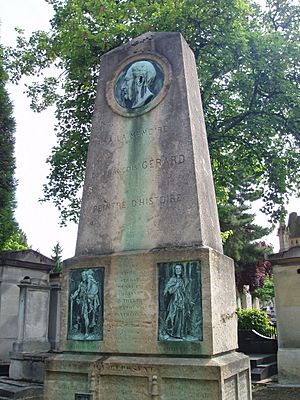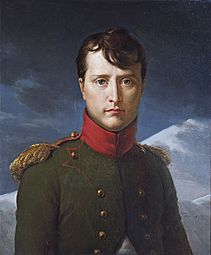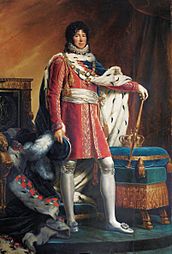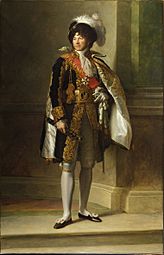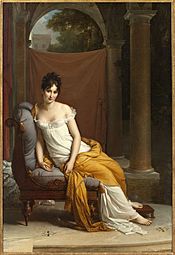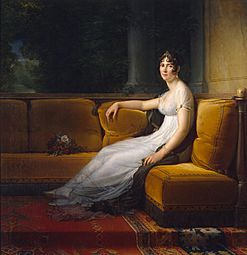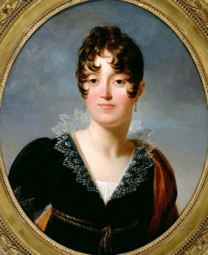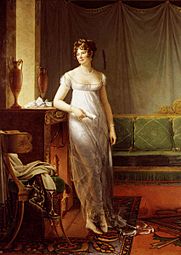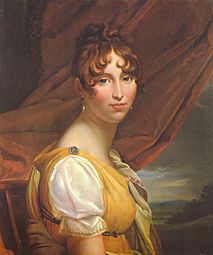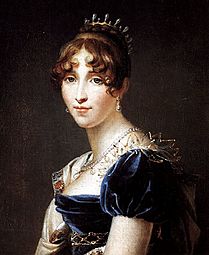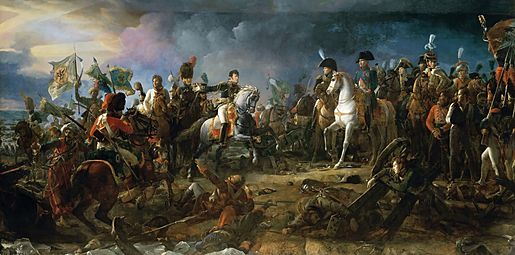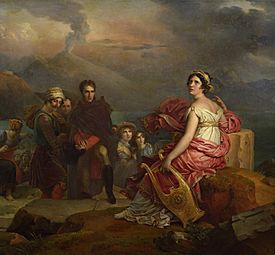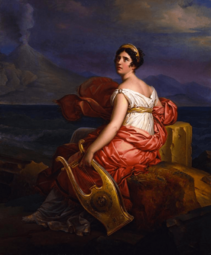François Gérard facts for kids
Quick facts for kids
Francois Gérard
|
|
|---|---|
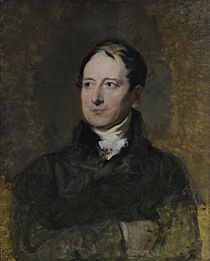
Francois Gérard aged 54,
by Sir Thomas Lawrence |
|
| Born |
François Pascal Simon Gérard
12 March 1770 |
| Died | 11 January 1837 (aged 66) |
| Nationality | French |
| Education | Pajou, Brenet, David |
| Known for | Portrait painting |
François Pascal Simon Gérard (French pronunciation: [fʁɑ̃swa paskal simɔ̃ ʒeʁaʁ], born March 12, 1770 – died January 11, 1837) was a very famous French painter. He was born in Rome, a city in Italy. His father worked there for the French ambassador, and his mother was Italian. In 1809, Emperor Napoleon made him a noble, giving him the title Baron Gérard. After that, he was known as Baron Gérard.
The Life of François Gérard
François Gérard was born in Rome. When he was twelve, he got into a special school in Paris called the Pension du Roi. From there, he went to study with a sculptor named Augustin Pajou. After two years, he moved to the studio of a history painter, Nicolas-Guy Brenet. But he quickly left Brenet to study with the very famous artist Jacques-Louis David.
In 1789, Gérard tried to win the Prix de Rome. This was a big art prize, but his friend Girodet won it instead. The next year, 1790, Gérard tried again. However, his father passed away, and he had to go to Rome with his mother.
He returned to Paris in 1791. He was very poor and needed to find work that paid right away. His former teacher, David, helped him. Some people believe Gérard helped David paint a famous portrait of Louis-Michel Le Pelletier de Saint-Fargeau in early 1793. In the same year, David asked Gérard to join a group called the revolutionary tribunal. This group made serious decisions, but Gérard always stayed away from their meetings.
In 1794, Gérard won first prize in an art competition. The painting was about The Tenth of August, which was when people stormed the Tuileries Palace during the French Revolution. His friend Girodet had been very successful in art shows in 1793 and 1794. This encouraged Gérard to create his famous painting Bélisaire in 1795. A miniaturist (a painter of tiny pictures) named Jean-Baptiste Isabey helped him.
In 1796, Gérard painted a portrait of his friend Isabey. This painting, which is now in the Louvre museum, was a big success. The money he earned from these two paintings allowed Gérard to create Psyche et l'Amour in 1797. Finally, in 1799, his portrait of Madame Mère (Napoleon's mother) made him one of the best portrait painters of his time.
By 1808, Gérard showed eight portraits at the Salon (a major art exhibition). In 1810, he showed fourteen! This shows how many portraits he painted every year. Many important people from the time of the Empire and the Bourbon Restoration in France, as well as famous people from all over Europe, had their portraits painted by Gérard.
He was so popular partly because he was charming and good at conversation. His home was a popular place for people to visit, just like his art studio. Famous people like Madame de Staël, George Canning, Talleyrand, and the Duke of Wellington all said how much they enjoyed his company.
Even though he was rich and famous, Gérard felt bad that he had given up his earlier dream of painting historical scenes. This type of painting was considered more important than portraits. Sometimes, he tried to compete with artists like Girodet in history painting. His painting Bataille d'Austerlitz (1810) showed great creativity. This was even more clear in his work L'Entrée d'Henri IV à Paris (now at Versailles), which he painted in 1817 for King Louis XVIII.
Gérard received many honors. He became a baron in 1809, a member of the Institut (a famous French academy) in 1812, and an officer of the Légion d'honneur. He was also the first painter to the king. Despite all this, he felt sad and discouraged. The July Revolution of 1830 made him even more worried. He passed away on January 11, 1837, after a short illness.
Gérard is most remembered for his beautiful portraits. The colors in some of his paintings have faded over time. However, his drawings still show how delicate and pure his lines were. His drawings of women are especially known for their innocent and open expressions. One of his students was Heinrich Christoph Kolbe.
Famous Artworks
-
Napoleon Bonaparte as First Consul, 1803
-
Portrait of Joachim Murat, King of Naples, 1811–1812
-
Another portrait of Joachim Murat
-
Portrait of Empress Joséphine
-
Portrait of Hortense de Beauharnais
-
Napoleon at the Battle of Austerlitz
See also
 In Spanish: François Gérard para niños
In Spanish: François Gérard para niños
- Neoclassicism in France


